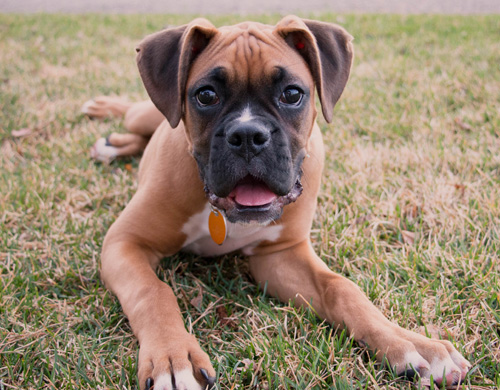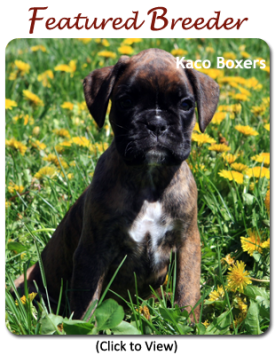
Boxer
Group: Working Dog Group
Origin: Germany
Height:
- – Males: 22 ½ to 25 inches;
– Females: 21 to 23 ½ inches.
Weight:
- – Males: approx. 70 lbs;
– Females: approx.60 lbs.
CLICK HERE to View Breeder Listings
Breed Profile
The Boxer is alert, dignified and self-confident. He is energetic, playful, and fun-loving with family and friends, with a particular love for children. He is, however, generally wary of strangers and makes an excellent guard dog. Always a loyal and intelligent family companion, the Boxer can be somewhat stubborn at times and early obedience training is highly recommended. Even tempered, noble in appearance, and fearless, the Boxer should not have any traits of aggression, extreme shyness or hyperactivity.
The ideal Boxer is of medium size with a square build. His nose is broad and the top of his muzzle appears slightly pushed in, leaving the jaw a bit undershot. His coat is short, shiny and tight to the body. The colours are fawn and brindles of varying shades. On the face, white may replace part or all of the black mask. The markings on the face should always enhance the true Boxer expression. His gait is firm with a free stride and proud appearance. He combines strength and agility with elegance and style. His twinkling black eyes show his intelligence and emotions. His face wrinkles up into expressions of curiosity, excitement, happiness, surprise, or sadness.
Today, the Boxer is often seen participating in Obedience, Tracking, Agility and, due to his natural instincts to guard and defend, he is also seen training in Schutzhund. Boxers are also used to work as Search and Rescue Dogs as well as Therapy Dogs.
A Brief History of the Boxer
The Boxer as a unique breed originated in the late 1800s in the Munich area of Germany. The breed was developed from several other breeds, including the Bulldog, the Great Dane, the Brabant Bullenbeisser (a Mastiff-type dog), and others. Originally bred for hunting and holding prey, the Boxer was later used as a guard dog.
By 1895, a Boxer Club was formed in Munich and the first Boxer Standard was developed as a guide for future breeding. Much of this first standard still remains in the standards of today. He was introduced to North America after the end of World War I and since then, the breed’s popularity has grown immensely.
For further details on the history of the Boxer, see:
- Short History of the Boxer Breed by Judy Voran
A Brief History of the Boxer
The Boxer as a unique breed originated in the late 1800s in the Munich area of Germany. The breed was developed from several other breeds, including the Bulldog, the Great Dane, the Brabant Bullenbeisser (a Mastiff-type dog), and others. Originally bred for hunting and holding prey, the Boxer was later used as a guard dog.
By 1895, a Boxer Club was formed in Munich and the first Boxer Standard was developed as a guide for future breeding. Much of this first standard still remains in the standards of today. He was introduced to North America after the end of World War I and since then, the breed’s popularity has grown immensely.
For further details on the history of the Boxer, see:
- Short History of the Boxer Breed by Judy Voran
Did You Know?
- The Boxer was one of the first breeds selected in Germany for police dog training.
- The Boxer Club of Canada was founded in 1947 and has members from across Canada and in the United States.
- The Boxer was officially recognized by the American Kennel Club in 1904.
- The Boxer is ranked 10th most registered breed by the American Kennel Club.
- Between 1947 and 1970, the Boxer breed won four “Best in Show” awards at the prestigious Westminster Kennel Club.
Photo credit: Redsand Boxers
Health Issues
Boxers, as with other breeds, are susceptible to some health problems, some of a genetic nature, others viral. The Boxer — Health Issues document includes information on some of the known health concerns found in the breed.
If you are considering the adoption of a Boxer puppy, or any breed, it is very important to be selective in choosing a responsible and reputable breeder. Ensure that the prospective puppy’s parents have all health clearances. This should include, among others, hip x-rays to exclude hip dysplasia and eyes should be checked to see that they are normal and PRA clear. (For more information on selecting a breeder, see the articles on the General Information page.)
- Boxer — Health Concerns
- Canine Inherited Disorders Database — Boxer
- Canine Health Information Center (CHIC) — Providing a source of health information for owners, breeders, and scientists that will assist in breeding healthy dogs. CHIC is a centralized canine health database jointly sponsored by the AKC/Canine Health Foundation (AKC/CHF) and the Orthopedic Foundation for Animals (OFA).
- Health and Nutrition — Growing section of the Canada’s Guide to Dogs website which includes information on several health and nutrition related issues.
- AKC Canine Health Foundation — Working towards developing scientific advances in canine health.
- OFA – Companion Animal Eye Registry (CAER)
- Orthopedic Foundation for Animals (OFA)
- Ontario Veterinary College (OVC)
- University of Pennsylvania Hip Improvement Program (PennHip)
- HealthGene — HealthGene Corporation is the leading provider of veterinary DNA diagnostic services in Canada.
- Labgenvet — Laboratory of Veterinary Genetics is a Canadian diagnostic laboratory that offers a comprehensive service of DNA tests for veterinary genetic diseases.

Grooming Information
- Grooming — This section of the Canada’s Guide to Dogs website includes tips, articles and information covering all aspects of dog grooming along with a listing of Groomers from across Canada.
Training Resources
- Training — For training information, see this growing section of the Canada’s Guide to Dogs website for tips, articles, as well as listings of training centres across Canada.
Additional Information
- The Worldwide Boxer — A detailed guide to Judging the Boxer
- Coat Colors in Boxers from the ABC
- White Boxers and Deafness by Bruce Cattanach
- Boxer Pedigree Database
- Council of Docked Breeds — “Tail docking is a very emotive subject the world over. The Council of Docked Breeds (CDB) campaigns to protect the freedom to choose the tail docking option. Based in the UK it is a non-profit making organisation manned by dog breeders.”
- Clubs, Sports & Activities — For information on the many sports and activities you can get involved in with your dog.
- Working Dogs — The Working Dogs section of the Canada’s Guide to Dogs website provides information and listings of organizations that are involved in various dog jobs, such as Guide Dogs, Therapy Dogs, Police Dogs, Protection Dogs, and much more.
Quick Facts
- The adult male Boxer ranges from 22 1/2 to 25 inches (57-64 cm) at the withers. The female is slightly smaller at 21 to 23 1/2 inches (53-60 cm).
- Adult male Boxers can weigh from 65 to 85 pounds and females in general weigh about 15 pounds less.
- Typically, the Boxer does not bark without cause and is known to have an uncanny sense to distinguish between friend and foe.
- One of the distinguishing characteristics of the breed is his uniquely expressive face.
Famous Boxers
Here are just a few stories of the many Boxers who have become famous throughout the years:
Stubby
The most decorated war dog of World War I and the only dog to be promoted to Sergeant through combat is said to be a Boxer named Stubby. He fought in 17 battles saving his regiment from mustard gas attacks, found and comforted wounded soldiers, and even caught a German spy. Although there are rumours that Stubby was a Pit Bull, many historical books confirm that Sergeant Stubby was a Boxer.
Simon
Simon, an 80-pound Boxer, served as a guide dog and companion for his visually impaired owner for four years. One morning, as Simon walked with his owner, David Furukawa and his son Will to school, a speeding car ran through a stop sign and barrelled toward them as they were crossing the road. Witnesses say the courageous guide dog sprung into action by pushing David’s son out of the oncoming vehicle’s path, sadly taking the brunt of the impact on himself. David was knocked to the pavement and suffered a broken elbow, knee and heel. As David was rushed to the hospital, a badly injured Simon refused to leave the boy’s side as he was transported to his nearby home. When Simon was sure that Will was okay, he laid down on the floor and tragically was overcome by his wounds. “He sacrificed himself to make sure my son was OK,” a grateful David said of Simon. “His legacy will live on…forever.”
Carmen
Carmen, a 9-year old Boxer, rose to Internet fame after she tried desperately to save the life of her owner, Ben Ledford, from a house fire in Ohio. First responders to the fire found Carmen on top of Ben Ledford, trying to shelter his face from the heat, smoke and flame, according to WCPO. Ledford died in hospital and Carmen was taken to a critical care veterinary hospital where she battled severe lung damage and smoke inhalation. Carmen has since been taken in by her owner’s brother, Phil. Fans of Carmen donated more than $29,000 toward her care on the Crowdrise website. Phil Ledford said: “It’ll be tough in that sense, seeing Carmen everyday, because she will remind me of Ben, but it’ll be like having a piece of him around.”
*NOTE 1: CHIC – The Canine Health Information Center “is a database of consolidated health screening results from multiple sources. Co-sponsored by the Orthopedic Foundation for Animals (OFA) and the American Kennel Club (AKC) Canine Health Foundation, CHIC works with parent clubs to identify health screening protocols appropriate for individual breeds. Dogs tested in accordance with the parent club established requirements, that have their results registered and made available in the public domain are issued CHIC numbers.” To learn more, visit: www.caninehealthinfo.org
*NOTE 2: The Fédération Cynologique International (FCI) is the World Canine Organization, which includes 91 members and contract partners (one member per country) that each issue their own pedigrees and train their own judges. The FCI recognizes 344 breeds, with each being the “property” of a specific country. The “owner” countries write the standards of these breeds in co-operation with the Standards and Scientific Commissions of the FCI, and the translation and updating are carried out by the FCI. The FCI is not a breed registry nor does it issue pedigrees.
Breed Listing
Quick Links
Get In Touch
- Email: canadasguidetodogs@gmail.com
- Email: info@canadasguidetodogs.com
- Visit us on Facebook: www.facebook.com/CanadasGuideToDogs
— CanadasGuideToDogs.com is an Amazon Associate as well as a participant in various affiliate programs, as such fees are earned from qualifying purchases.



